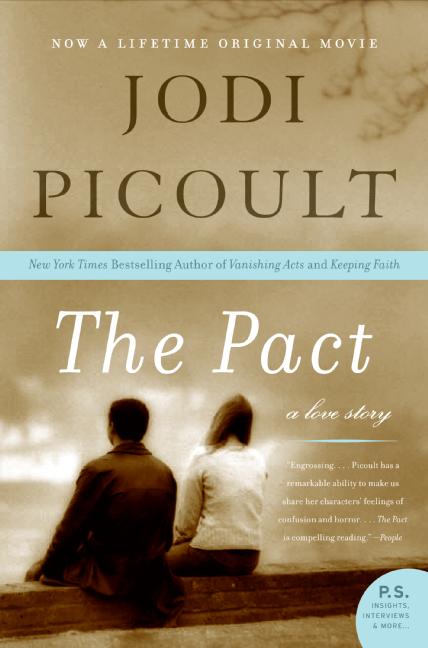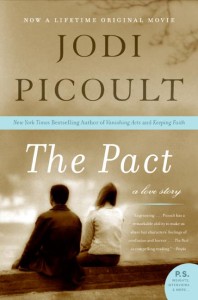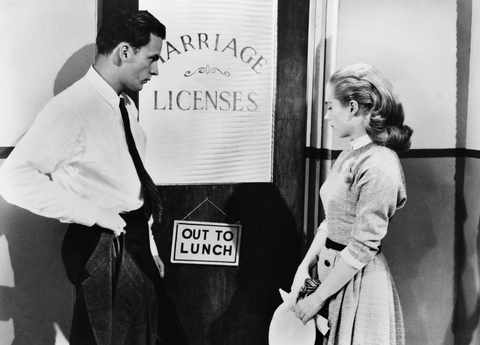Relationship Dependency: “I’m Okay if You’re Okay”
 The Pact by Jodi Picoult
The Pact by Jodi Picoult
Part One
What I’m Reading . . . **This article is not a standard review of the book but a discussion of how the story weaves in lessons in psychology and behavior.
The Pact tells the story of a teen couple, Christopher and Emily, whose functioning is so fused that when a gun goes off during an embrace and kills Emily, Christopher isn’t sure who pulled the trigger. Neither are the police.
Was it murder or suicide?
Is suicide a one-person act? What if you are so involved with another person that your feelings and movements seem to be ‘extensions’ of the other person? If you feel what the other feels, is it murder to pull the trigger?
“Fusion” and Relationship Dependency
Have you ever acted against your own best thinking out of fear that someone you love would be upset? Of course you have. Fusion is natural and is part of all close relationships. It’s part of being a child to give in to the decisions of parents and other adults with greater experience and power. Throughout life it’s part of being human to take into account what other people think and feel. The definition of ‘psychopath’ is someone who does not and maybe cannot take into account the feelings of others.
But what if the way you feel is so intertwined with the feelings of another person that you are afraid to do anything that might cause the other person anxiety? What if your feelings are so intertwined with the feelings of another person that you are unable to know, state, and follow through with personal goals?
It’s possible that two people in a relationship or even an entire family can be held in a holding pattern as a result of fusion between family members. If one person is floundering, the family is floundering. (See upcoming Life on “Cold Comfort Farm.”)
Fusion is the clinical term used to describe when the thoughts and feelings of one person are interwoven with the thoughts and feelings of another person. When the fusion is extremely intense, the individual will have great difficulty thinking for self or managing his or her behavior separately. At times of high anxiety functioning as a separate thinking self can be literally impossible.
 Note: We’re not talking about hesitation in doing what you “feel” like doing. Feelings come and go. If we act on our emotions without using our thinking—our lives aren’t going to go very well.
Note: We’re not talking about hesitation in doing what you “feel” like doing. Feelings come and go. If we act on our emotions without using our thinking—our lives aren’t going to go very well.
The downside of fusion comes in when a person moves against what he or she truly thinks. An example would be when one spouse agrees to avoid behavior that the other spouse holds as dangerous when he or she does not agree on the dangerousness of the activity. False compliance is often behind not trying new activities, skirting educational opportunities, avoiding making new friends, not keeping up with old friends, dressing to keep the other calm and not voicing differing political ideas. There’s a reason voting booths are private. Sometimes the decision of whether or not to have children is one person’s acquiescence to the other’s wishes though he or she will usually view the decision as mutual.
Relationship dependence often comes out as saying “Yes” when we mean “No.” The more important the person is to us, the more our emotions and thoughts will be interwoven with him or her. Compliance with the anxious person’s wishes holds off anxiety for the moment. This ‘false compliance,’ over time, contributes to distance in the relationship.
More on Fusion here. Psychology for Dummies.
Back to Jodi Picoult’s The Pact:
In Picoult’s novel, the fusion of the young adult Emily and Christopher begins at the beginning of their lives due to the emotional closeness of the two families (next door neighbors) and the interdependence (not an automatically ‘bad’ thing) of the two mothers. Emily and Christopher even spent time together in the same maternity ward bassinet at the hospital. How’s that for ‘close?’ As children, Christopher and Emily engineered communication systems to go from bedroom to bedroom. They two shared every experience and every step in growing up. The assumption of their families and anyone else observing the happy couple was that these best friends turned teen lovers would marry and the circle of family closeness would be complete.
And why not? The young people seemed happy, their relationship ‘charmed.’ So, how do these perfectly matched teenagers end up in each other’s arms, one with a bullet the head?
Part Two, tomorrow.






